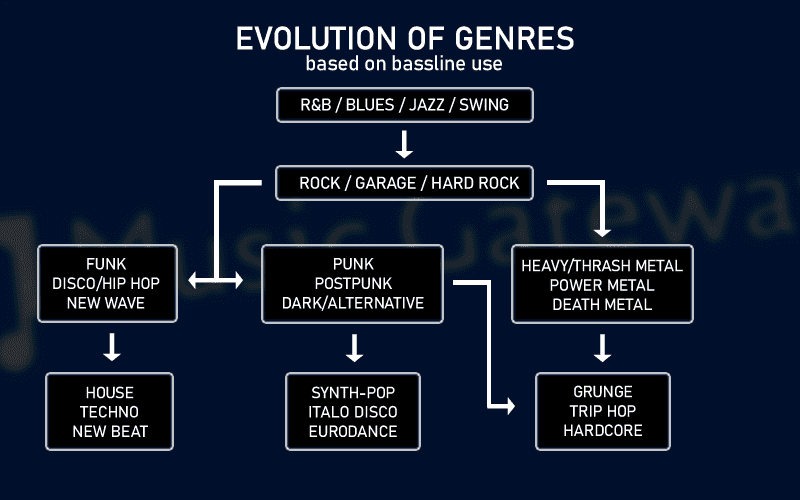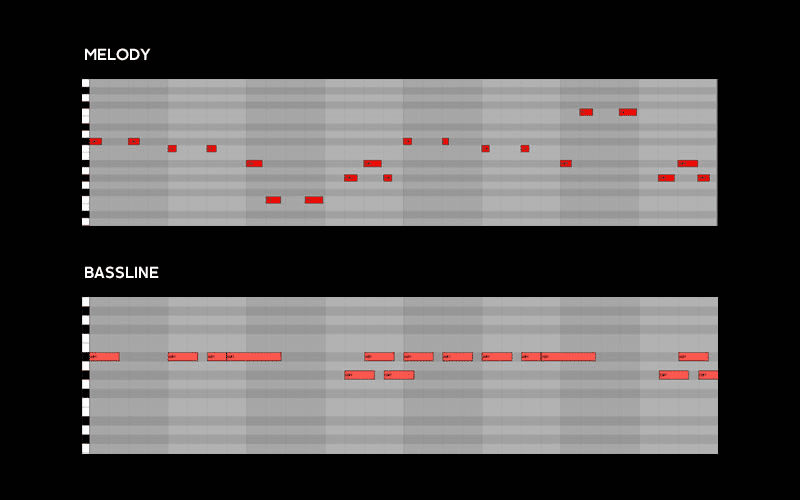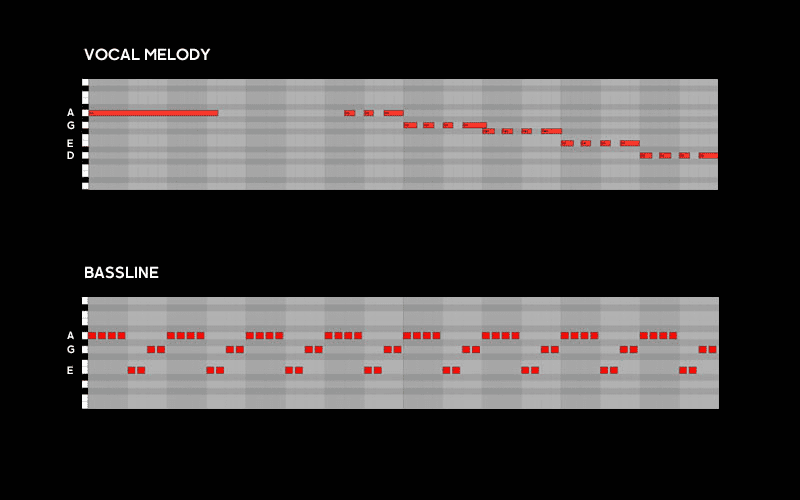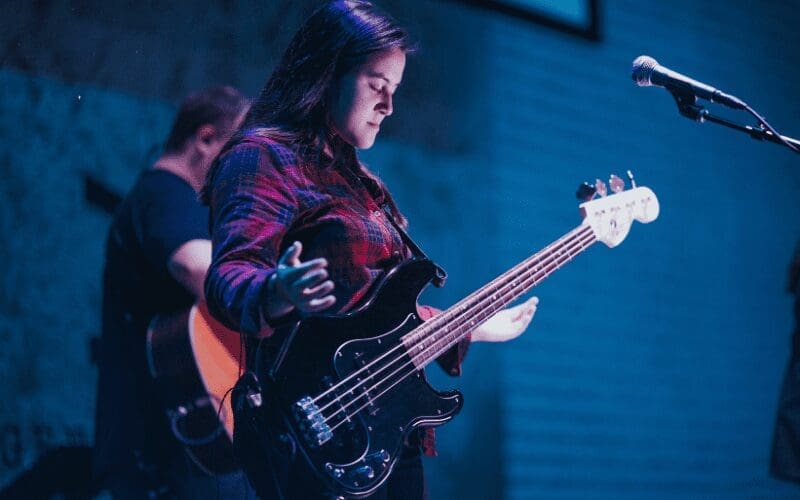Welcome to our full guide on how to write a bass line in music, for your productions. Based on what has been produced back in the day!

Just look over at any moment that you were hearing anything and started moving your feet. What was happening there?
While it’s not just about ears but also frequencies shaking your body, rhythm totally gets you. Rhythm moves us, and bass lines are practically the most important thing about it.
That doesn’t mean the rest of the instruments don’t matter in an oeuvre. Please, we’re talking about the core of a song – in most genres – and how it is applied and felt throughout our senses.
That being said, we’re gathered here to explore the origins of the bass line. And how to prepare ourselves to create from scratch an idea of where we want to go with a song no matter what genre it is.
We will also be going over how to write a bass line, easy bass lines in music, and bass line music. So if that sounds like something that interests you, then keep reading!
What Is A Bass Line In Music?

The bass part, also known as the bass line, is the lowest-pitched part of a song.
From funk to disco, from dub to house, bass lines are quite likely to be heard sometimes more than other instruments. What is formed from a bass line pattern is the rhythm section which will lead the song all throughout.
Don’t get me wrong, a piano/organ player has to learn bass playing with their left hand or pedal. As the bass lines are to call the melody and chords to action from the very beginning. Unless you want to go ambient or play with textures or some sort of concrete/experimental music.
Bass lines are made of what is called “riffs”. In quiet repetition for popular genres, but always leading the song pointing out the key/scale that must be followed.
It defines the harmony even though not at 100%. Since many advanced musicians know technically and theoretically how to go deeper and further on scale moves or inversions.
What about the drums accompanying them? They must engage in order to respect the flow of the rhythm.
Bass lines may either adapt to the drums or vice versa. Classical and modern music in the early 50s is a good example of how double basses (the instrument) were adapting to drums and other percussive patterns.
That changed in the 60s introducing the electric bass guitar. Which may I say defined the rock era and later on, the funk era. In order to evolve into what we today know as electronic-bass-music.
How To Write A Bass Line

For starters, you can create easy bass lines. A simple type of groove with whatever instrument is in your hands, looking over the whole beat measure. Kicking in vs the off-beat in a classic 4/4 measure and start creating a rhythm or pattern you feel comfortable with.
Just by going down to the lowest notes, you will start feeling the sensation of a rhythm, of a movement, rather than a melodic experience.
It is a great time-saving idea. Especially if you don’t have the possibility of buying a bass guitar or using electronic instruments on the computer.
So, let’s take this as if you were using a DAW or playing with a real instrument. Although we are going to show everything on a piano roll so everyone has the same starting point.
Types Of Bass Lines

We are going to break down into the 4 types of bass lines you can play with:
Classic Mono-Rhythmic
There is practically no variation on the line, it respects the same note (on the key of the scale) every single kick.
You may find this on techno and house simplest songs.
Follow-The-Drums
Something we have talked about above.
Blues, rock and others show how important it is to maintain a level of impact between the notes of the bass line and the drums kicking.
The root of the chords is a must-follow as well.
Mimic Bass Line
Preferable for bangers and found on 99% of the one-hit-wonders over the decades.
The bassline follows the lead guitar, voice or synth. Important to rely on the impact of the melodic riff.
Bass Solo
Something in between the choruses, perhaps a bridge, where the bassist goes their own way.
Like a guitar solo but is often used in funk and disco music.
How To Make A Bass Line – Where To Start?

Before we move into some references to work with, do you remember ‘Another One Bites The Dust’ by Queen and ‘Good Times’ by Chic? They share a follow-the-drums bass line (known as a walking bass line in the very first part), with very rhythmic and easy-going vocals.
Try listening to both songs and paying special attention to those notes while picturing the rhythm in your head. Do it as a warm-up for what’s next.
These are often called the funky bass lines and may be of influence for your future bass line beats.
As of now we are entering some music theory you ought to be familiar with in order to learn how to write bass lines.
If you have your bass guitar or synthesizer at hand, start by playing random notes in a basic mono style. Until you feel partially satisfied with the pattern.
That note you are playing will mostly be the key of the scale for the song, in other words, the core of it. Probably a simple but walking bass line.
Next step should be catching up with some natural scales. In order to find a possible melody that will lead the song and be layered with the bass line.
Yes, many musicians start their songs with funky bass lines, walking melodies and then build up the rest of the song from there.
Famous Bass Lines
Don’t Go – Yazoo

Let’s first use this song as a reference, ‘Don’t Go’ by Yazoo. Written by Vince Clark and released back in the golden era of synth-pop, 1982.
The song is on the scale of A#m for which the first chord is also A#m. That allows us to use mainly the notes A# C# and F was given the 3rd note being a minor.
For that reason, the melody could have been written either starting from A#, C#, or F. And it appears to be that Vince clearly chose C# for its “happiness” and driving. Let’s be honest, this song is way beyond catchy.
Moving forward. With a drum machine already programmed on a 4/4 pattern, you can see how the bass line is always pointing out the direction as the lead melody pops up in the beginning and then in the choruses.
The bass line starts with the first kick and the melody as well, forming a power-chord (A# on the bass, C# on the lead melody). You can always play along with that small and basic technique even using the 5th note (in this case, F) to practice the psychological reaction to a connection between keynote and chord note.
Around The World – Daft Punk

For the second reference, we will use ‘Around The World’ by Daft Punk. Written by Guy-Manuel de Homem-Christo and Thomas Bangalter in the mid 90’s.
Although the root here is the scale of G, we find the bass line starting at A and not when the first 4/4 kick drops but the second.
This is a very interesting way of composition, giving impact as the drums are really driving here. We might say it is a follow-the-drum kind of bass line.
This case is similar to ‘Don’t Go’ with the bass line going one way and the melody going the other way. But more complex since the notes of the root chord are not specifically chosen.
Sometimes it is a question of hearing more than following the theory in a strict form. The fun about music composition is when you know you are using the right scale but the melody does not have to be “that easy one”.
I Feel Love – Donna Summer

The last reference is a song that changed the game back in the mid 70’s.
Giorgio Moroder loved playing with easy bass lines and blues bass lines due to his rock music past, but at the time of creating something brand new he felt that technology could be of a great help.
Arpeggiators came along and the use of only 3 notes per beat set the basis for the Disco era. Let’s analyze ‘I Feel Love’ performed by the one and only Donna Summer.
Look at how the notes change from A to E and G on every beat, shaping a non-stop pattern. That goes on until the chorus where some chords also enter the song.
In the vinyl version, the extended production lasts several minutes with this initial rhythm. Could you get any tired of it? Never!
It is a great example of how a type of rhythm on a bass line can define a song, a genre, a complete era.
More than forty years later, just by trying a similar pattern will automatically make people think of Giorgio and Donna. But you can play with delay effects after removing some notes. And the psychological affection will be different even though the rhythm sounds similar.
Remember, music is about tension and release.
In other words: no wonder why these three songs are all-time hits!
To Sum Up

Writing bass lines relies on the ability to create unique patterns of rhythm. That, later on, will fill the idea of a song either being happy, moving, sad, strong, funky, bluesy.
The perfect advice would be for you to have different songs from different styles strictly analyzed and learned on your very own. Then compare and start projects from scratch with those ideas.
Music theory parts like harmony are necessary if you are a bassist too. Since you are either accompanying the song or the song harmonies are accompanying your instrument.
Be careful what you do when composing or producing with too many notes. As they might not fit the message of the oeuvre.
When you look at music theory for bassists, you should pay attention to variations and try some dominant seventh chords to follow if you are learning. So that way, you hear differences in the pattern.
Old School DJs back in the day were all day listening to songs trying to find the right spot to mix in and out.
More than just a bunch of songs, DJ sets are to tell a story and the bass line, believe it or not. And mark the direction and the strength of a mix in most electronic styles but in others like post-punk and synth-pop as well.
As we have seen, it is not mandatory to start a bass line on the very first kick, but always feel or think as though the note was there sounding.
There you have it. We hope that you enjoyed our complete guide on how to write a bass line!










